oil viscosity NISSAN FRONTIER 2018 Owner´s Manual
[x] Cancel search | Manufacturer: NISSAN, Model Year: 2018, Model line: FRONTIER, Model: NISSAN FRONTIER 2018Pages: 502, PDF Size: 4.85 MB
Page 332 of 502

5.Use Cruise Control
∙ Using cruise control during highway driving helps maintain a steady
speed.
∙ Cruise control is particularly effective in providing fuel savings when driving
on flat terrains.
6. Plan for the Shortest Route
∙ Utilize a map or navigation system to determine the best route to save
time.
7. Avoid Idling
∙ Shutting off your engine when safe for stops exceeding 30–60 seconds
saves fuel and reduces emissions.
8. Buy an Automated Pass for Toll
Roads
∙ Automated passes permit drivers to use special lanes to maintain cruis-
ing speed through the toll and avoid
stopping and starting. 9.
Winter Warm Up
∙ Limit idling time to minimize impact to fuel economy.
∙ Vehicles typically need no more than 30 seconds of idling at start-up to
effectively circulate the engine oil be-
fore driving.
∙ Your vehicle will reach its ideal oper- ating temperature more quickly
while driving versus idling.
10. Keeping your Vehicle Cool
∙ Park your vehicle in a covered parking area or in the shade whenever pos-
sible.
∙ When entering a hot vehicle, opening the windows will help to reduce the
inside temperature faster, resulting in
reduced demand on your A/C sys-
tem. ∙ Keep your engine tuned up.
∙ Follow the recommended scheduled
maintenance.
∙ Keep the tires inflated to the correct pressure. Low tire pressure increases
tire wear and lowers fuel economy.
∙ Keep the wheels in correct alignment. Improper alignment increases tire wear
and lowers fuel economy.
∙ For vehicles equipped with
, use
4H or 4L position only when necessary.
4-wheel drive operation lowers fuel
economy.
∙ Use the recommended viscosity engine oil. For additional information, refer to
“Engine oil and oil filter recommenda-
tions” in the “Technical and consumer
information” section of this manual.
INCREASING FUEL ECONOMY
Starting and driving5-25
Page 429 of 502
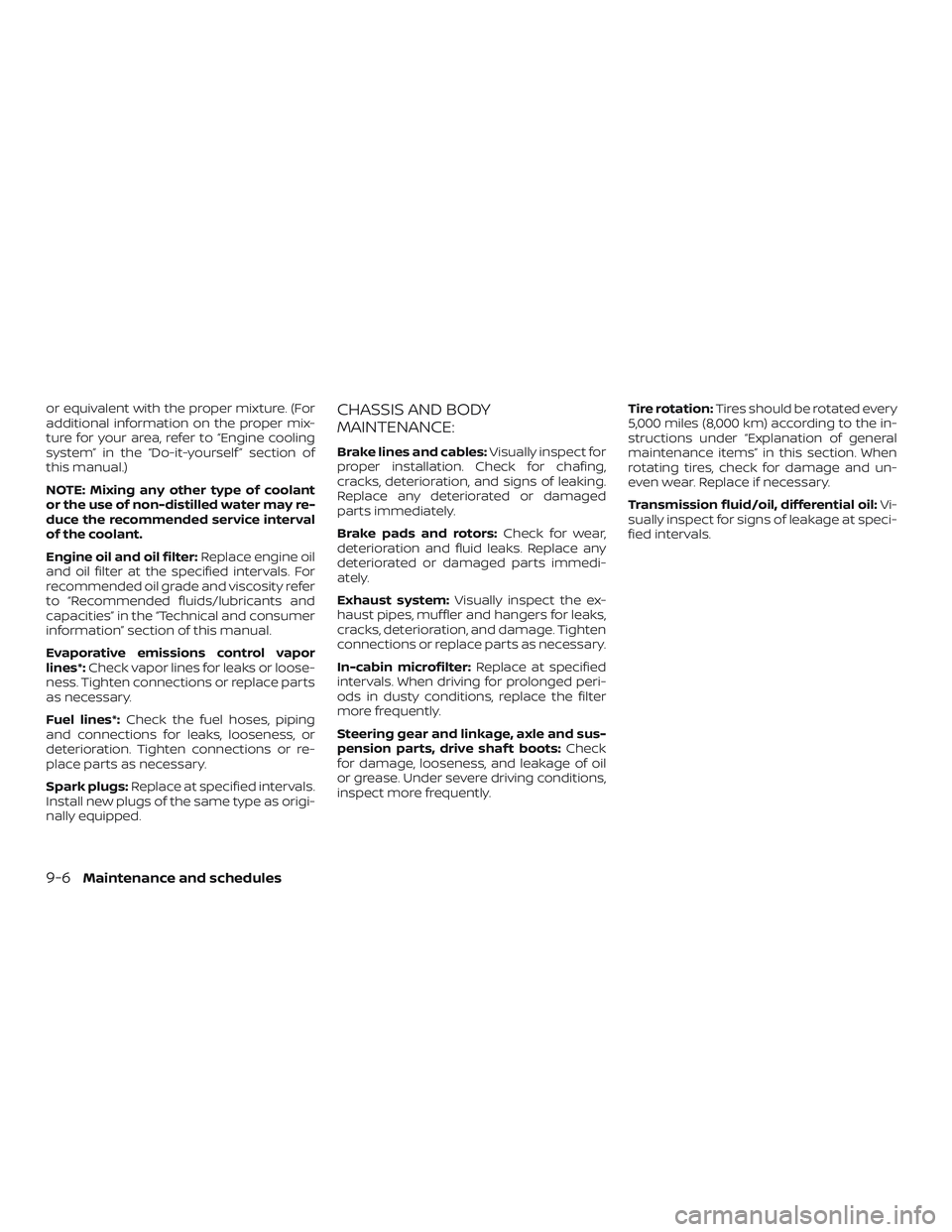
or equivalent with the proper mixture. (For
additional information on the proper mix-
ture for your area, refer to “Engine cooling
system” in the “Do-it-yourself ” section of
this manual.)
NOTE: Mixing any other type of coolant
or the use of non-distilled water may re-
duce the recommended service interval
of the coolant.
Engine oil and oil filter:Replace engine oil
and oil filter at the specified intervals. For
recommended oil grade and viscosity refer
to “Recommended fluids/lubricants and
capacities” in the “Technical and consumer
information” section of this manual.
Evaporative emissions control vapor
lines*: Check vapor lines for leaks or loose-
ness. Tighten connections or replace parts
as necessary.
Fuel lines*: Check the fuel hoses, piping
and connections for leaks, looseness, or
deterioration. Tighten connections or re-
place parts as necessary.
Spark plugs: Replace at specified intervals.
Install new plugs of the same type as origi-
nally equipped.CHASSIS AND BODY
MAINTENANCE:
Brake lines and cables: Visually inspect for
proper installation. Check for chafing,
cracks, deterioration, and signs of leaking.
Replace any deteriorated or damaged
parts immediately.
Brake pads and rotors: Check for wear,
deterioration and fluid leaks. Replace any
deteriorated or damaged parts immedi-
ately.
Exhaust system: Visually inspect the ex-
haust pipes, muffler and hangers for leaks,
cracks, deterioration, and damage. Tighten
connections or replace parts as necessary.
In-cabin microfilter: Replace at specified
intervals. When driving for prolonged peri-
ods in dusty conditions, replace the filter
more frequently.
Steering gear and linkage, axle and sus-
pension parts, drive shaf t boots: Check
for damage, looseness, and leakage of oil
or grease. Under severe driving conditions,
inspect more frequently. Tire rotation:
Tires should be rotated every
5,000 miles (8,000 km) according to the in-
structions under “Explanation of general
maintenance items” in this section. When
rotating tires, check for damage and un-
even wear. Replace if necessary.
Transmission fluid/oil, differential oil: Vi-
sually inspect for signs of leakage at speci-
fied intervals.
9-6Maintenance and schedules
Page 441 of 502

The following are approximate capacities. The actual refill capacities may be a little different. When refilling, follow the procedure
described in the “Do-it-yourself ” section to determine the proper refill capacity.
Fluid typeCapacity (approximate) Recommended Fluids/Lubricants
Metric
Measure US
Measure Imperial
Measure
Fuel 80 L 21-1/8 gal 17-5/8 gal• For additional information, refer to “Fuel recommenda-
tions (without Flexible Fuel Vehicle option)” or “Flexible
Fuel Vehicle (FFV) fuel recommendation (if so equipped)”
in this section.
Engine oil*1
Drain and refill
*1: For additional
information, refer to
“Engine” in the “Do-it-
yourself ” section of
this manual. QR25DE
With oil filter
change 4.6 L 4-7/8 qt 4 qt • Genuine “Nissan Motor Oil 5W-30 SN” is recommended.
• If the above motor oil is not available, use an equivalent
motor oil that matches the above grade and viscosity.
For additional information, refer to “Engine oil and oil filter
recommendation” in this section.
Without oil
filter change 4.3 L 4-1/2 qt 3-3/4 qt
VQ40DE With oil filter
change 5.1 L 5-3/8 qt 4-1/2 qt • Genuine “Nissan Motor Oil Ester 5W-30 SN” is
recommended.
• If the above motor oil is not available, use an equivalent
motor oil that matches the above grade and viscosity.
For additional information, refer to “Engine oil and oil filter
recommendation” in this section.
Without oil
filter change 4.8 L 5-1/8 qt 4-1/4 qt
Engine coolant
(with reservoir) QR25DE
9.4 L 2-1/2 gal 2-1/8 gal
• Pre-diluted Genuine NISSAN Long Life Antifreeze/
Coolant (blue) or equivalent
VQ40DE 10.2 L 2-3/4 gal 2-1/4 gal
Manual transmission gear oil 5 M/T
2.9 L 3-1/8 qt 2-1/2 qt • Genuine NISSAN Manual Transmission Fluid (MTF) HQ
Multi 75W-85
• If Genuine NISSAN Manual Transmission Fluid (MTF) HQ
Multi is not available, API GL-4, Viscosity SAE 75W-85 may
be used as a temporary replacement. However, use
Genuine NISSAN Manual Transmission Fluid (MTF) HQ
Multi as soon as it is available.
6 M/T 4X2 4.0 L 4-1/4 qt 3-1/2 qt
6 M/T 4X4 4.2 L 4-1/2 qt 3-3/4 qt
RECOMMENDED FLUIDS/
LUBRICANTS AND CAPACITIES
10-2Technical and consumer information
Page 442 of 502
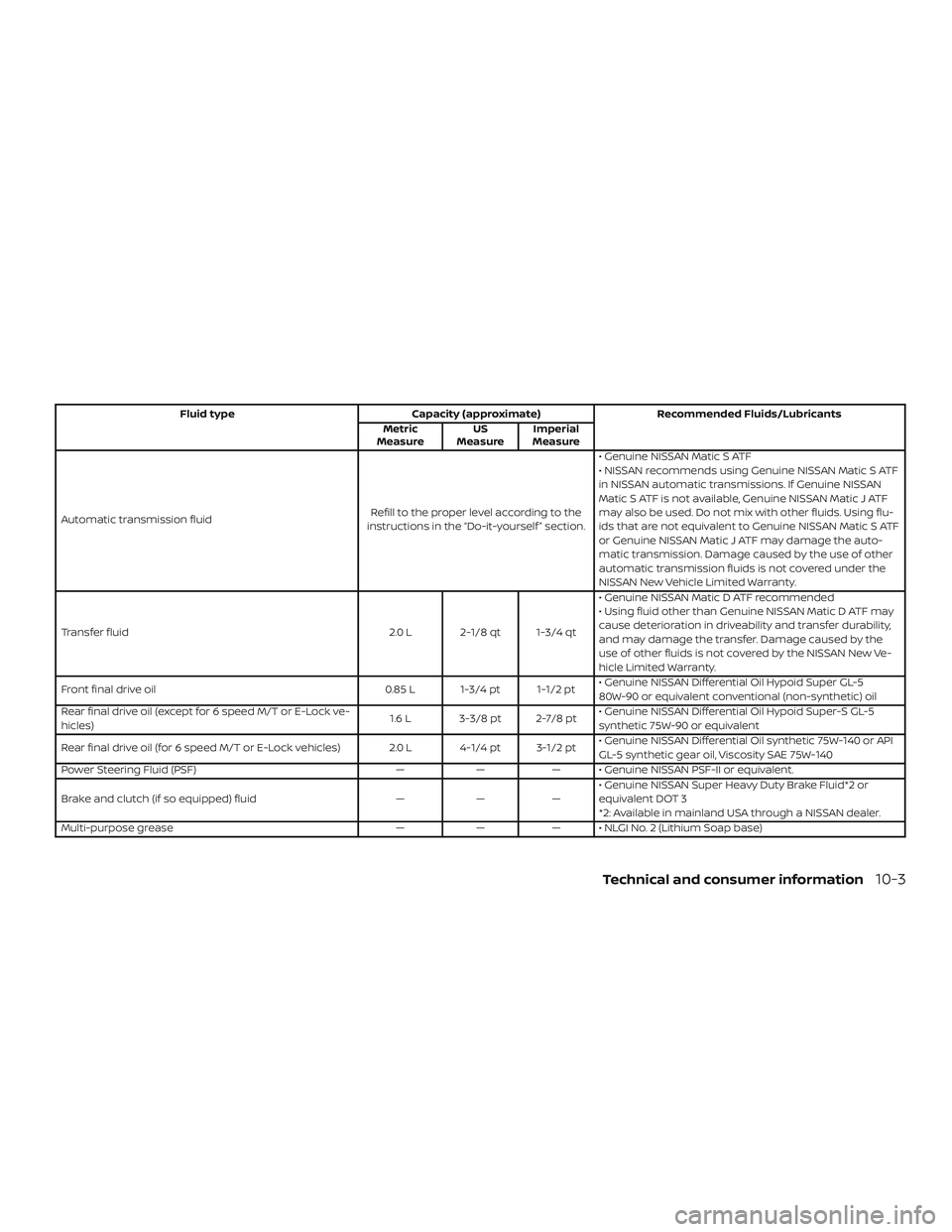
Fluid typeCapacity (approximate) Recommended Fluids/Lubricants
Metric
Measure US
Measure Imperial
Measure
Automatic transmission fluid Refill to the proper level according to the
instructions in the “Do-it-yourself ” section. • Genuine NISSAN Matic S ATF
• NISSAN recommends using Genuine NISSAN Matic S ATF
in NISSAN automatic transmissions. If Genuine NISSAN
Matic S ATF is not available, Genuine NISSAN Matic J ATF
may also be used. Do not mix with other fluids. Using flu-
ids that are not equivalent to Genuine NISSAN Matic S ATF
or Genuine NISSAN Matic J ATF may damage the auto-
matic transmission. Damage caused by the use of other
automatic transmission fluids is not covered under the
NISSAN New Vehicle Limited Warranty.
Transfer fluid 2.0 L 2-1/8 qt 1-3/4 qt• Genuine NISSAN Matic D ATF recommended
• Using fluid other than Genuine NISSAN Matic D ATF may
cause deterioration in driveability and transfer durability,
and may damage the transfer. Damage caused by the
use of other fluids is not covered by the NISSAN New Ve-
hicle Limited Warranty.
Front final drive oil 0.85 L 1-3/4 pt 1-1/2 pt• Genuine NISSAN Differential Oil Hypoid Super GL-5
80W-90 or equivalent conventional (non-synthetic) oil
Rear final drive oil (except for 6 speed M/T or E-Lock ve-
hicles) 1.6 L 3-3/8 pt 2-7/8 pt• Genuine NISSAN Differential Oil Hypoid Super-S GL-5
synthetic 75W-90 or equivalent
Rear final drive oil (for 6 speed M/T or E-Lock vehicles) 2.0 L 4-1/4 pt 3-1/2 pt • Genuine NISSAN Differential Oil synthetic 75W-140 or API
GL-5 synthetic gear oil, Viscosity SAE 75W-140
Power Steering Fluid (PSF) ——— • Genuine NISSAN PSF-II or equivalent.
Brake and clutch (if so equipped) fluid ———• Genuine NISSAN Super Heavy Duty Brake Fluid*2 or
equivalent DOT 3
*2: Available in mainland USA through a NISSAN dealer.
Multi-purpose grease ——— • NLGI No. 2 (Lithium Soap base)
Technical and consumer information10-3
Page 450 of 502

ENGINE OIL AND OIL FILTER
RECOMMENDATIONS
Selecting the correct oil
It is essential to choose the correct grade,
quality and viscosity engine oil to ensure
satisfactory engine life and performance.
For additional information, refer to “Recom-
mended fluids/lubricants and capacities”
in this section. NISSAN recommends the
use of an energy conserving oil in order to
improve fuel economy.Select only engine oils that meet the
American Petroleum Institute (API) certifi-
cation or International Lubricant Standard-
ization and Approval Committee (ILSAC)
certification and SAE viscosity standard.
These oils have the API certification mark
on the front of the container. Oils which do
not have the specified quality label should
not be used as they could cause engine
damage.
Oil additives
NISSAN does not recommend the use of oil
additives. The use of an oil additive is not
necessary when the proper oil type is used
and maintenance intervals are followed.
Oil which may contain foreign matter or
has been previously used should not be
used.
Oil viscosity
The engine oil viscosity or thickness
changes with temperature. Because of
this, it is important to select the engine oil
viscosity based on the temperatures at
which the vehicle will be operated before
the next oil change. Choosing an oil viscos-
ity other than that recommended could
cause serious engine damage.
Selecting the correct oil filter
Your new NISSAN vehicle is equipped with a
high-quality Genuine NISSAN oil filter. When
replacing, use a Genuine NISSAN oil filter or
its equivalent for the reason described in
“Change intervals.”
LTI2061
Technical and consumer information10-11
Page 451 of 502
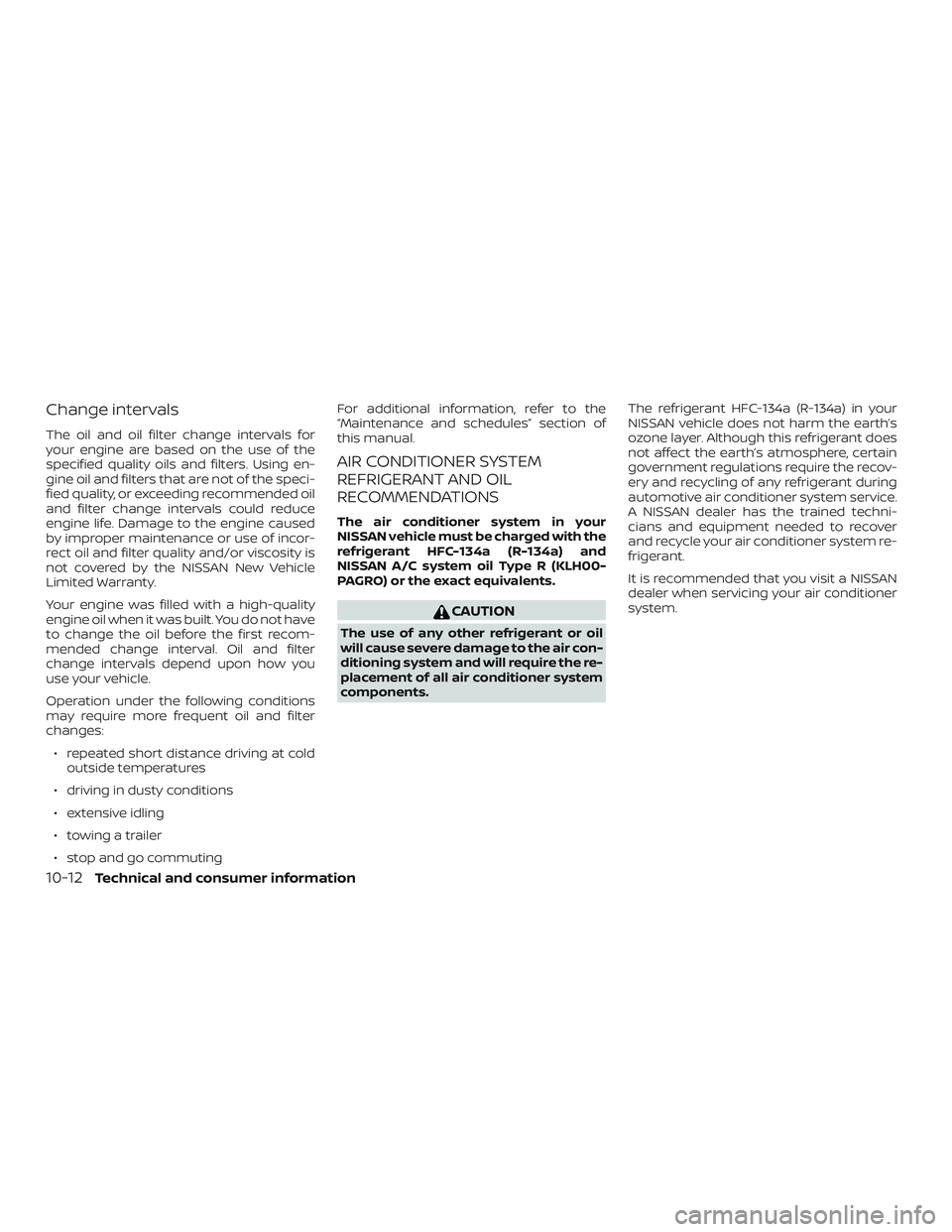
Change intervals
The oil and oil filter change intervals for
your engine are based on the use of the
specified quality oils and filters. Using en-
gine oil and filters that are not of the speci-
fied quality, or exceeding recommended oil
and filter change intervals could reduce
engine life. Damage to the engine caused
by improper maintenance or use of incor-
rect oil and filter quality and/or viscosity is
not covered by the NISSAN New Vehicle
Limited Warranty.
Your engine was filled with a high-quality
engine oil when it was built. You do not have
to change the oil before the first recom-
mended change interval. Oil and filter
change intervals depend upon how you
use your vehicle.
Operation under the following conditions
may require more frequent oil and filter
changes:∙ repeated short distance driving at cold outside temperatures
∙ driving in dusty conditions
∙ extensive idling
∙ towing a trailer
∙ stop and go commuting For additional information, refer to the
“Maintenance and schedules” section of
this manual.
AIR CONDITIONER SYSTEM
REFRIGERANT AND OIL
RECOMMENDATIONS
The air conditioner system in your
NISSAN vehicle must be charged with the
refrigerant HFC-134a (R-134a) and
NISSAN A/C system oil Type R (KLH00-
PAGRO) or the exact equivalents.
CAUTION
The use of any other refrigerant or oil
will cause severe damage to the air con-
ditioning system and will require the re-
placement of all air conditioner system
components.
The refrigerant HFC-134a (R-134a) in your
NISSAN vehicle does not harm the earth’s
ozone layer. Although this refrigerant does
not affect the earth’s atmosphere, certain
government regulations require the recov-
ery and recycling of any refrigerant during
automotive air conditioner system service.
A NISSAN dealer has the trained techni-
cians and equipment needed to recover
and recycle your air conditioner system re-
frigerant.
It is recommended that you visit a NISSAN
dealer when servicing your air conditioner
system.
10-12Technical and consumer information
Page 490 of 502
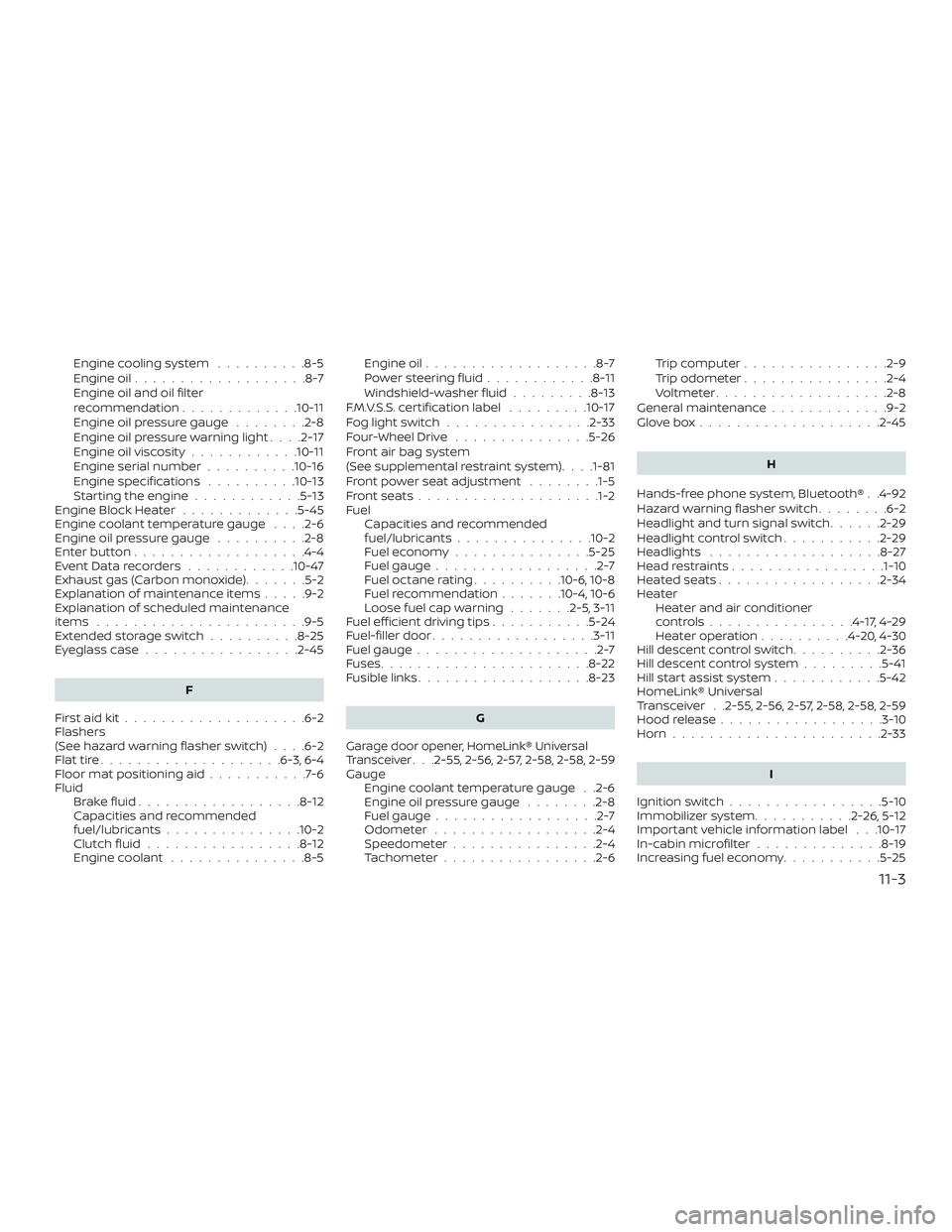
Engine cooling system..........8-5
Engine oil ...................8-7
Engine oil and oil filter
recommendation .............10-11
Engine oil pressure gauge ........2-8
Engine oil pressure warning light ....2-17
Engine oil viscosity ............10-11
Engine serial number ..........10-16
Engine specifications ..........10-13
Starting the engine ............5-13
Engine Block Heater .............5-45
Engine coolant temperature gauge ....2-6
Engine oil pressure gauge ..........2-8
Enterbutton...................4-4
EventDatarecorders............10-47
Exhaust gas (Carbon monoxide) .......5-2
Explanation of maintenance items .....9-2
Explanation of scheduled maintenance
items .......................9-5
Extended storage switch ..........8-25
Eyeglasscase.................2-45
F
Firstaidkit....................6-2
Flashers
(See hazard warning flasher switch) ....6-2
Flattire....................6-3,6-4
Floormatpositioningaid...........7-6
Fluid Brakefluid..................8-12
Capacities and recommended
fuel/lubricants...............10-2
Clutchfluid.................8-12
Engine coolant ...............8-5 Engine oil
...................8-7
Powersteeringfluid............8-11
Windshield-washer fluid .........8-13
F.M.V.S.S. certification label .........10-17
Foglightswitch................2-33
Four-Wheel Drive ...............5-26
Front air bag system
(See supplemental restraint system) . . . .1-81
Front power seat adjustment ........1-5
Frontseats....................1-2
Fuel Capacities and recommended
fuel/lubricants...............10-2
Fuel economy ...............5-25
Fuel gauge ..................2-7
Fueloctanerating..........10-6,10-8
Fuel recommendation .......10-4,10-6
Loose fuel cap warning .......2-5,3-11
Fuel efficient driving tips ...........5-24
Fuel-filler door ..................3-11
Fuel gauge ....................2-7
Fuses .......................8-22
Fusiblelinks...................8-23
G
Garage door opener, HomeLink® Universal
Transceiver. . .2-55, 2-56, 2-57, 2-58, 2-58, 2-59
Gauge Engine coolant temperature gauge . .2-6
Engine oil pressure gauge ........2-8
Fuel gauge ..................2-7
Odometer ..................2-4
Speedometer ................2-4
Tachometer .................2-6 Trip computer
................2-9
Trip odometer ................2-4
Voltmeter...................2-8
General maintenance .............9-2
Glovebox....................2-45
H
Hands-free phone system, Bluetooth® . .4-92
Hazardwarningflasherswitch........6-2
Headlight and turn signal switch ......2-29
Headlightcontrolswitch...........2-29
Headlights ...................8-27
Headrestraints.................1-10
Heatedseats..................2-34
Heater Heater and air conditioner
controls................4-17,4-29
Heater operation ..........4-20,4-30
Hill descent control switch ..........2-36
Hill descent control system .........5-41
Hill start assist system ............5-42
HomeLink® Universal
Transceiver . .2-55, 2-56, 2-57, 2-58, 2-58, 2-59
Hood release ..................3-10
Horn.......................2-33
I
Ignition switch .................5-10
Immobilizer system ...........2-26,5-12
Important vehicle information label . . .10-17
In-cabinmicrofilter ..............8-19
Increasing fuel economy ...........5-25
11-3
Page 492 of 502
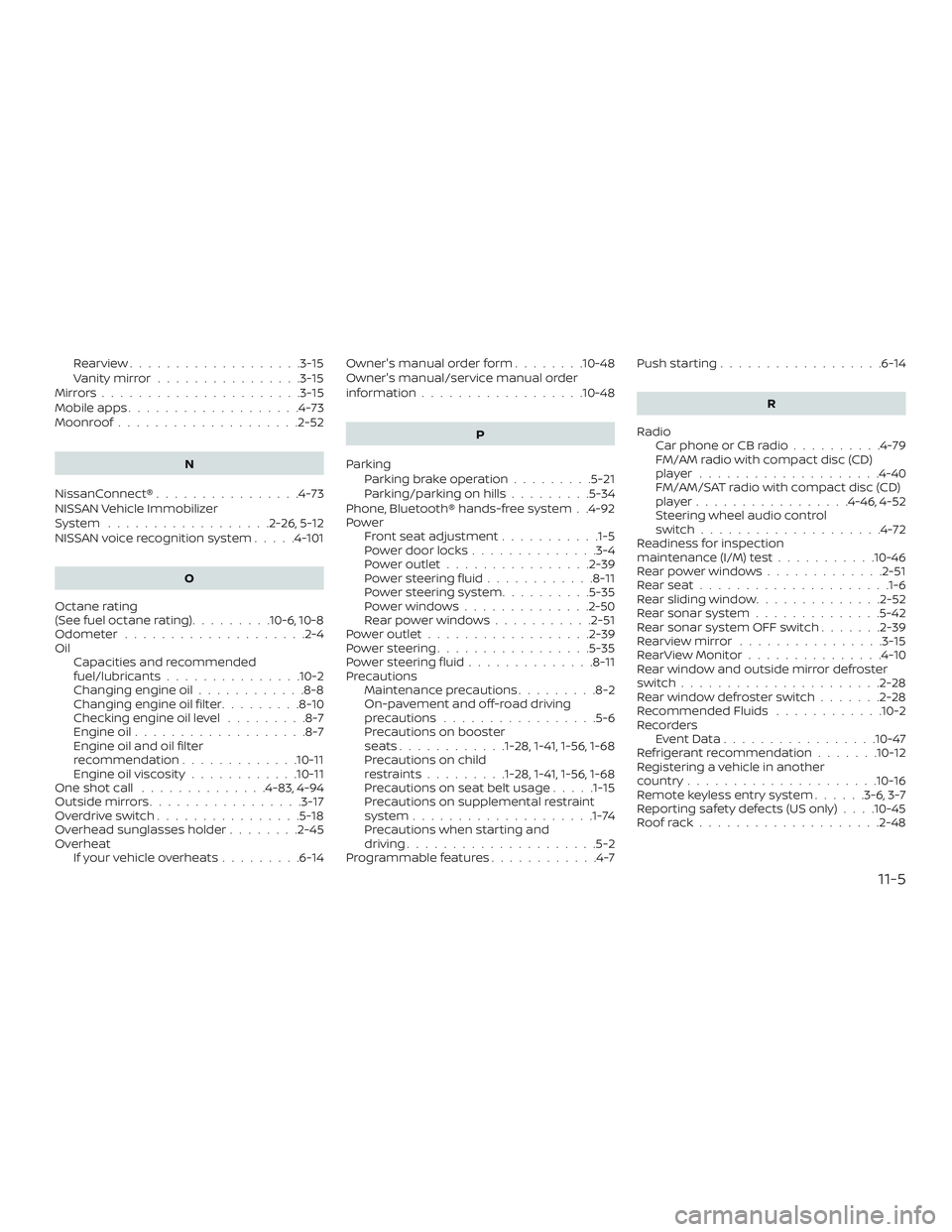
Rearview...................3-15
Vanitymirror................3-15
Mirrors......................3-15
Mobile apps ...................4-73
Moonroof ....................2-52
N
NissanConnect® ................4-73
NISSAN Vehicle Immobilizer
System ..................2-26,5-12
NISSAN voice recognition system .....4-101
O
Octane rating
(Seefueloctanerating).........10-6,10-8
Odometer ....................2-4
Oil Capacities and recommended
fuel/lubricants...............10-2
Changing engine oil ............8-8
Changing engine oil filter .........8-10
Checking engine oil level .........8-7
Engine oil ...................8-7
Engine oil and oil filter
recommendation .............10-11
Engine oil viscosity ............10-11
One shot call ..............4-83,4-94
Outsidemirrors.................3-17
Overdriveswitch................5-18
Overhead sunglasses holder ........2-45
Overheat Ifyourvehicleoverheats.........6-14 Owner's manual order form
........10-48
Owner's manual/service manual order
information..................10-48
P
Parking Parking brake operation .........5-21
Parking/parkingonhills.........5-34
Phone, Bluetooth® hands-free system . .4-92
Power Front seat adjustment ...........1-5
Power door locks ..............3-4
Poweroutlet................2-39
Powersteeringfluid............8-11
Power steering system ..........5-35
Powerwindows..............2-50
Rearpowerwindows...........2-51
Poweroutlet..................2-39
Powersteering.................5-35
Powersteeringfluid..............8-11
Precautions Maintenance precautions .........8-2
On-pavement and off-road driving
precautions .................5-6
Precautions on booster
seats............1-28, 1-41, 1-56, 1-68
Precautions on child
restraints.........1-28, 1-41, 1-56, 1-68
Precautions on seat belt usage .....1-15
Precautions on supplemental restraint
system ................... .1-74
Precautions when starting and
driving.....................5-2
Programmable features ............4-7Push starting
..................6-14
R
Radio Car phone or CB radio ..........4-79
FM/AM radio with compact disc (CD)
player....................4-40
FM/AM/SAT radio with compact disc (CD)
player.................4-46,4-52
Steering wheel audio control
switch....................4-72
Readiness for inspection
maintenance (I/M) test ...........10-46
Rearpowerwindows............ .2-51
Rearseat.................... .1-6
Rearslidingwindow..............2-52
Rear sonar system ..............5-42
Rear sonar system OFF switch .......2-39
Rearviewmirror ................3-15
RearViewMonitor...............4-10
Rear window and outside mirror defroster
switch......................2-28
Rearwindowdefrosterswitch.......2-28
Recommended Fluids ............10-2
Recorders EventData.................10-47
Refrigerant recommendation .......10-12
Registering a vehicle in another
country .....................10-16
Remote keyless entry system ......3-6,3-7
Reporting safety defects (US only) . . . .10-45
Roofrack................... .2-48
11-5